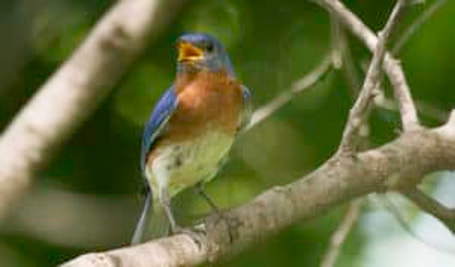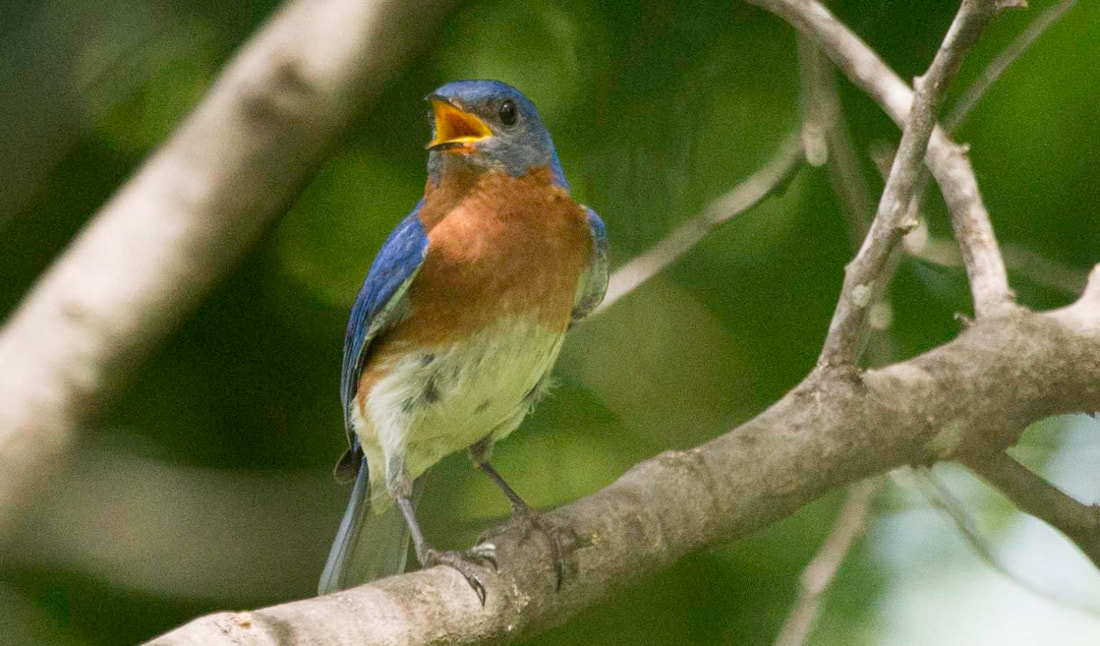Triple-digit heat is a challenge for birds, squirrels, snakes, and deer tooBy KELLY BOSTIAN
For the CCOF If you see birds panting like dogs and squirrels lounging like lizards, you’re probably sweating out another day of triple-digit heat in Oklahoma. Most of us find mid-summer heat almost unbearable without air-conditioned cars, swimming pools, or hammocks and shade trees, but at least people can sweat it out. Many wildlife species can’t sweat at all, but all have their own ways to cope with the heat. Knowing about animal behaviors can help you understand what you’re seeing, know where to look to observe wildlife—or how to avoid it. Birds exhibit a panting behavior that might lead some to think they look like they’re sick. Heat is just another factor that adds to life’s stresses for birds. Long stretches of excessive heat and drought can be hard on bird populations attempting to nest and rear young. “With their beak open, it’s a little bit like a dog panting,” said Dan Reinking, a senior wildlife biologist at the Sutton Avian Research Center in Bartlesville. “They will do whatever they can to stay cool. They will stay in the shade and they might be less active during the day.” Life goes on for birds, however, and many are in mid-summer nesting and rearing stages, said the author of the Oklahoma Breeding Bird Atlas. They have eggs to incubate, or young mouths to feed, so that means foraging and feeding duties continue no matter the weather, he said. “They may be less visible during the day but they have to keep going. Keeping your birdbath filled this time of year to provide water is something people can do to help,” he said. Oh, deer get hot too The state’s most visible large mammal, the white-tailed deer, also becomes less active during extreme heat, according to Dallas Barber, big game biologist with the Oklahoma Department of Wildlife Conservation. “During the heat of the day they’re trying to find a place that is shady and has a little breeze to help them stay cool and help keep the bugs off,” he said. During the heat of summer they are more strictly “crepuscular,” meaning they are most active during twilight hours in the morning and evening, he said. “They won’t be doing as much outside that timeframe related to about 30 minutes before and after sunrise and sunset,” he said. An adaptation seen in Oklahoma deer follows Bergmann’s rule for wildlife, he said. Named for 19th-century German biologist Carl Bergmann, the rule roughly states that larger sizes of species are found in colder environments. It’s hot, large or small “Our deer are smaller compared to their northern counterparts but obviously they are incredibly resilient and good at adapting to what conditions are at the time. If heat was a real big problem there would not be many deer in southern areas,” he said. Food sources change for deer as new springtime growth wilts. Summer’s heat hits does on top of their need to produce milk for fawns. Bucks are putting energy into growing new sets of antlers. “They will focus on things like ragweed, which is a great high-protein food source, as much as many of us with allergies don’t like it,” he said. A smaller mammal that is often seen in urban settings also shows a heat-coping behavior. It will lie flat, legs outstretched, on large branches or near the trunk of a shade tree. Yes, squirrels feel the heat too. “They are trying to increase that surface area to dissipate heat,” Barber said. “Anatomically or in behaviors, mammals will try to achieve that heat loss, like some desert species that have big ears that work like radiators,” he said. Being cold-blooded doesn’t help Snakes, reptiles, and amphibians aren’t all that crazy about extreme heat, either. “There’s a misconception about snakes and other reptiles loving the heat,” said Jake Bagley, a lifelong amateur herpetologist and an admin of the Oklahoma Snake Identification Network Facebook group. The informal name “cold-blooded” might be part of the reason for the misconception that a snake loves nothing more than a hot, sunny rock. The reptiles are “ectothermic,” which simply means they rely on external factors to control their body temperature. “The heat can be more dangerous to a snake than cold,” he said. “Some species are more heat-tolerant, like racers and coachwhips, but generally when it’s over 100 degrees you won’t see anything out during the day.” Some reptiles and amphibians practice “estivation” a sort of summer hibernation or torpor where they might retreat to moist rocky fissures or cool underground locations. Most reptiles just go into a nocturnal mode. The place and time to see reptiles and amphibians in summer is near permanent water bodies and starting about 30 minutes before sunset, Bagley said. This time of year, hardcore “herpers” like Bagley break out their flashlights and go looking for smooth and scaly critters at night. Having a flashlight at night is a good idea for anyone outdoors, especially campers who don’t want to step on something that wriggles, he said. For beginning herpers who want to see some of Oklahoma’s wide variety of snakes, slowly cruising a rural road near a permanent water body, where traffic is scant and speeds are slow, is a good place to intercept reptiles on their evening travels, he said. Kelly Bostian is an independent journalist writing for The Conservation Coalition of Oklahoma Foundation, a 501c3 non-profit dedicated to education and outreach on conservation issues facing Oklahomans. To learn more about what we do and to support Kelly’s work, see the About the CCOF page.
0 Comments
Leave a Reply. |
Archives
May 2024
Categories
All
|
Conservation Coalition of Oklahoma
P.O. Box 2751
Oklahoma City, OK 73101
[email protected]



